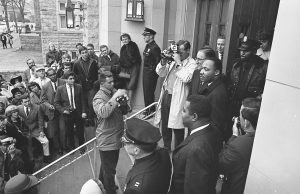Commentary: Time To Confront An Ugly Past
Movement To Rename Stapleton Relevant To Park Hill
By Jacqueline St. Joan and Genevieve Swift
Special to the GPHN

Photo by Mel Schlieltz, Rocky Mountain News collection/Denver Public Library
East of Park Hill there is a movement to rename Stapleton. That movement is relevant to Park Hill as well.
Many people know that Stapleton Airport was named to honor Denver’s Mayor Ben Stapleton (who held office from 1923-31 and again from 1935-47). His is a name synonymous with the era in Denver when the KKK controlled the Mayor and his appointees, as well as the Governor and the state’s highest political offices.
The Stapleton era was a reign of terror for minorities — Catholics, Jews, African Americans and immigrants. Here are just a few examples:
• In 1920 when a black fireman bought a home on Gaylord Street, white homeowners from the Clayton Improvement Association threatened his life.
• In 1921 a black post office clerk’s rental on Gilpin Street was bombed twice.
• In 1923 eleven wooden crosses were ablaze around Denver. Regular Klan meetings occurred on South Table Mountain. There were weekly rallies near “Kastle” Rock. Ruby Hill, southwest of downtown, was often lit up.
• In 1924 black students from Morey Jr. High were barred from swimming classes. When students from Manual Training High School tried to attend a school dance, the Denver school board ordered that social functions be segregated. The Park Hill Improvement Association advocated for racially separated schools.
• In 1925 Shorter AME Church just west of Park Hill was burned down, many believe, by the KKK.
• Klansmen harassed the Jewish enclave along West Colfax. Jewish-owned department stores such as Neusteter’s were boycotted.
• Jewish activists and Catholic priests were terrorized by death threats. Crosses were burned at Catholic churches and at Regis University.
• Judges were Klansmen and juries were drawn from Klan membership lists.
It was an era of political power for those advocating white Protestant supremacy as a means to define who was a “true American.” Ben Stapleton empowered and enabled those KKK voices. Is it any wonder many feel the slight, the insult, the disregard, the old burn, when they see or hear that name – Stapleton?
He did what he promised
Ben Stapleton was a duplicitous opportunist who took advantage of the populism organized by the Klan at a grassroots level. Estimates of Colorado KKK membership range between 40,000 and 70,000, (17,000 documented in Denver).
• In 1923, during Stapleton’s first mayoral campaign, he accepted KKK support, but to appease Jewish and Catholic voters, distanced himself from the Klan with this statement: “True Americanism needs no mask or disguise. Any attempt to stir up racial prejudices or religious intolerance is contrary to our constitution and is therefore un-American.” Later it was discovered that Stapleton was a Klansman; through him the KKK infiltrated city government.
• In 1924 anti-Klan opponents tried to recall Stapleton. Needing Klan support, he reaffirmed his commitment: “I have little to say, except that I will work with the Klan and for the Klan in the coming election, heart and soul. And if I am reelected, I shall give the Klan the kind of administration it wants.” With KKK financial backing, Stapleton won the recall against an unpopular opponent. Then he did exactly what he’d promised – appointed Klansmen as police chief, city attorney, manager of safety, and other key positions.
Tensions building anew
African Americans who moved east out of Five Points risked crossing understood racial lines—first, Race Street, then Colorado Boulevard, then Park Hill, and past Monaco Boulevard, meeting resistance along the way.
Mortgage companies “red-lined” certain neighborhoods. Real estate brokers “steered” blacks away from white neighborhoods. Neighborhood associations urged white homeowners to attach racially restrictive covenants to their property. Segregated housing patterns led to segregated schools, which led to the 1973 U. S. Supreme Court order to desegregate, which required 20 years of busing under court supervision.
There have always been resisters along the way. In the Stapleton era it was Philip Van Cise and Phillip Hornbein, Father Matthew Smith, and others.
In the 1960s, Park Hill neighbors became part of that proud history. Activists like J. Carlton Babbs and Jules Mondschein and Dick Young and Marge Gilbert helped organize the Park Hill Action Committee to fight for racial justice.
The Greater Park Hill Community association was born of these efforts to make room for people of all races and classes. Today residents of Park Hill are often forced by economic circumstances and the absence of adequate assistance to sell their family homes to newcomers who have more income to spend on real estate and repairs.
Tensions are building as a result of new residents not being respectful of local history and culture in vulnerable areas in the city. Forest City’s affordable housing promises at Stapleton are behind schedule and some worry they will go unfulfilled.
A trigger for conversation
It’s time to take a stand. In a nation whose current president drew support from white supremacists and American nationalists, we must stay vigilant. We are losing ground on progress made in Park Hill in the 60’s. and 70s A proudly diverse neighborhood isn’t what it used to be.
We need to push the community of Stapleton to, not only remove the name from its place of honor, but to realize the ideal vision of the “Greenbook”; an inclusive neighborhood that has seamless boundaries within the city of Denver.
White people can’t change the story of our collective past, but we can change how that story develops. White supremacy has always been a part of our country’s, our state’s and our city’s history, and its ideas have not gone away. They go underground and simmer in the dark, sensing when they might survive in the light of day. This is one of those times. We must speak up, even when it is uncomfortable.
We must have the courage to listen to each other, to be willing to fix what we can of the wrongs that have been done. The person and the name, Stapleton, is a trigger for this much needed conversation.
Visit www.renameforall.com to see how the legacy of the KKK lives on in our communities and sign our petition change.org/p/denver-city-council-change-the-name-stapleton. Join the Rename St*pleton for All conversation.
If not now, when?
Jacqueline St. Joan and Genevieve Swift are part of the Rename St*pleton for All leadership team. Editor’s note: In mid-December, the Stapleton Foundation for Sustainable Urban Communities announced plans to drop the word “Stapleton” from its name. The foundation will begin doing business as “The Foundation for Sustainable Urban Communities” effective this month.

Stapleton community day of reflection discusses history of neighborhood name
April 27, 2018 @ 1:49 pm
[…] in fact, could not ignore the Klan. Although his administration turned a blind eye to the 11 burning crosses intended to intimidate non-Klansmen in 1923, the reports of Catholics and Jews that were kidnapped […]